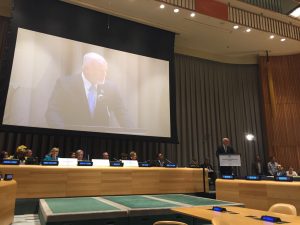As delivered
Statement by the Peter Thomson, President of the UN General Assembly, at Opening of High Level Dialogue on Building Sustainable Peace for All: Synergies between the 2030 Agenda for Sustainable Development and Sustaining Peace
24 January 2017
 Honorable Ministers and High-level Dignitaries,
Honorable Ministers and High-level Dignitaries,
Secretary-General,
Excellencies,
Ladies & Gentlemen
Thank you everyone for attending today’s Dialogue, with special thanks to those of you who have covered such long distances to be here.
Ladies and gentlemen, in June 1945 when the United Nations was established, world leaders – compelled by the colossal loss of life and destruction caused by World War II – came together to pledge themselves to a common purpose: to ‘save succeeding generations from the scourge of war’ through the establishment of the United Nations.
Over the seven decades that have followed, as global dynamics, weapons of war, and threats to peace, have evolved, the United Nations has grappled with how best to achieve its founding Charter aims. It is a history punctuated by both notable successes and some truly regrettable failures.
Responding to that history and the lessons it has taught us, in April of last year, the General Assembly and the Security Council decided to advance a new approach to peace. In a welcome demonstration of bi-cameral cooperation, both chambers adopted the sustaining peace resolutions thereby signaling a new cross-sectoral, comprehensive, and integrated approach to the maintenance of international peace and security.
Of course, those resolutions were not agreed in a vacuum and the spirit of the 2030 Agenda for Sustainable Development can be seen in the decisions contained therein.
Just as the 2030 Agenda recognizes the importance of fostering peaceful, just and inclusive societies to achieving each of the seventeen Sustainable Development Goals, the sustaining peace resolutions emphasize the importance of sustainable development to sustaining peace. The sustaining peace resolutions give special place to conflict prevention, gender equality, addressing root causes of conflict and protecting human rights.
Taken in tandem, the 2030 Agenda and the sustaining peace resolutions make it clear that Member States regard sustainable development and sustaining peace are two agendas that stand or fall together.
Excellencies, it is against this backdrop that I have convened this High Level Dialogue, as a tangible step to mutually reinforce our commitment to sustaining peace and sustainable development.
On assuming office last September as President of the 71st Session, I made a solemn commitment to do all in my power to deliver a universal push for implementation of the 2030 Agenda.
To do so, it is clear to me that concrete action is required on two fronts.
First, it is essential that we generate unstoppable momentum in these early years of SDG implementation. To do so we must stress the universality of the 2030 Agenda and harness the collective powers of government, business, civil society and academia to reach these higher goals. We must mobilize the resources required to lift hundreds of millions from poverty and ensure universal access to essential services. And we must deliver fresh reserves of political will to tackle inequalities, transition to the green economies and protect our planet’s life support systems.
Second, we must recognise sustainable peace as both an enabler and an outcome of sustainable development, and invest financially and intellectually in sustaining peace across our world.
Without sustaining peace, achieving sustainable development is next to impossible; this we know to be true.
Where conflict, violence and extremism prevail over peace, justice and tolerance; vital infrastructure and industries are destroyed; youth are diverted from education and opportunity; national resources are pillaged; and propagandas of hatred and division override rational discourse for the common good.
Protracted conflicts currently affect 17 countries and 2 billion people live in countries troubled by fragility, conflict and violence. We should also be aware that 95 per cent of refugees and internally displaced persons in developing countries have been affected by the same 10 conflicts since 1991.
If we are to meet the 2030 Agenda’s central tenet of leaving no-one behind, it is incumbent upon us to reach out to all of those people affected by conflict and fragility. Simultaneously, we must prevent millions more from having their lives and their livelihood destroyed by future violence and conflict.
Our purpose today therefore is to explore the mutually-reinforcing ways in which we can both deliver the SDGs and create the conditions for sustainable peace.
Our aim is to draw from the experiences and insights of participants on how to make our work to implement these agendas comprehensive, integrated and mutually reinforcing.
We will be asking how Member States themselves, as well as United Nations entities and intergovernmental forums such as the UN Peacebuilding Commission, can evolve to facilitate their dual achievement.
It will be your contributions across the day that will define the success of our efforts, including during the expert panel later this morning, and at three parallel workshops in the afternoon on, empowering women and youth, managing natural resources, and strengthening transparent, inclusive, and accountable institutions.
In your interventions, I ask you to share bold and thought-provoking ideas that complement the example and tone set by our new Secretary General, who I welcome today to the General Assembly for the first time since taking office.
Excellencies, today’s event is also a first for another reason. I am honored to be joined for this event by the Presidents of the Security Council and ECOSOC, the Chair of the Peacebuilding Commission, and the Secretary-General. This marks the first time that the heads of these principal organs and entities have come together to address how we can achieve a world at peace, by bringing coherence to our work across the three pillars, and ensuring that we are constantly working to cement the foundations needed to sustain peace.
Let us take this example of coherence and cooperation as our starting point for today’s discussions.
And then let us imagine the fruits of such cooperation. A world in which extreme poverty is permanently eradicated, where women participate fully in societies enjoying equal reward for equal work, where fresh water, sustainable energy and decent work are available for all.
A world of resilient cities and infrastructure, reduced inequality, and sustainable consumption and production.
A world in which the challenges of climate change are overcome, and ocean terrestrial ecosystems preserved.
A world, where finally, all people can thrive in just, peaceful, inclusive societies, built on effective and equitable institutions, and partnerships at all levels.
Excellencies, building on the momentum for conflict prevention and sustaining peace launched on January 10th so powerfully into the 2017 work of the Security Council on 10 January, let today’s High Level Dialogue be a benchmark in truth-telling on the subject.
May our dialogue today provide us with greater clarity for our communal way forward.
May it lead to a strengthening of our universal resolve to achieve a peaceful and sustainable world for all.
May it reinforce the inescapable reality that “We the Peoples” exist on but one planet, and that if the future of our grandchildren is to be safeguarded, this planet must be ruled by both sustained peace and sustainable development.
I thank you for your attention and look forward to today’s dialogue.

